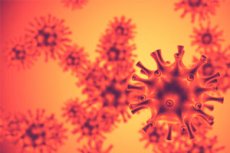
目前可用的流感药物只能在病毒感染后才开始发挥作用,但如果一种药物能够从一开始就预防感染呢?现在,斯克里普斯研究所和阿尔伯特·爱因斯坦医学院的科学家们已经开发出类似药物的分子,可以做到这一点,干扰流感感染的第一阶段。
这些抑制剂通过专门针对甲型流感病毒表面的蛋白质血凝素,阻止病毒进入人体呼吸道细胞。这项发表在《美国国家科学院院刊》上的研究成果,代表着在研发预防流感感染药物方面迈出了重要一步。
“我们试图针对流感感染的第一阶段,因为最好首先预防感染,但这些分子也可用于抑制感染后的病毒传播,”该研究的主要作者、斯克里普斯研究所结构生物学教授伊恩·威尔逊 (Ian Wilson) 说。
这些抑制剂需要进一步优化和测试,才能评估其作为人体抗病毒药物的疗效,但研究人员表示,这些分子最终可能有助于预防和治疗季节性流感感染。而且与疫苗不同,这些抑制剂可能不需要每年更新。
研究人员之前发现了一种小分子 F0045(S),它与 H1N1 流感病毒的结合和抑制能力有限。
“我们首先开发了一种高通量血凝素结合试验,使我们能够快速筛选大量小分子库,并通过这一过程找到了先导化合物 F0045(S),”该研究的主要作者、基因泰克高级首席科学家、斯克里普斯研究所前副教授 Dennis Wolan 博士说。
在这项研究中,团队试图优化F0045(S)的化学结构,以创造出具有更佳药物特性和更特异性结合病毒能力的分子。首先,Wolan实验室利用由两届诺贝尔奖得主、论文合著者K. Barry Sharpless博士首创的“SuFEx点击化学”,创建了一个包含F0045(S)原始结构不同变体的大型候选分子库。通过扫描该库,研究人员鉴定出两种分子——4(R)和6(R)——与F0045(S)相比,其结合亲和力更高。
威尔逊实验室随后创建了 4(R) 和 6(R) 与流感血凝素蛋白结合的 X 射线晶体结构,以确定分子的结合位点、其优异结合能力的机制以及需要改进的领域。
“我们发现这些抑制剂与病毒血凝素抗原的结合比最初的先导分子要紧密得多,”威尔逊说。“利用点击化学,我们实际上扩展了这些化合物与流感病毒相互作用的能力,使它们能够靶向抗原表面的更多位点。”
当研究人员在细胞培养中测试 4(R) 和 6(R) 以确认它们的抗病毒特性和安全性时,他们发现 6(R) 无毒,并且与 F0045(S) 相比,其在细胞中的抗病毒活性提高了 200 多倍。
最后,研究人员采用针对性的方法,进一步优化6(R),开发出化合物7,其表现出更优异的抗病毒活性。
“这是迄今为止开发出的最有效的小分子血凝素抑制剂,”主要研究作者 Seiya Kitamura 说道,他曾在斯克里普斯研究所担任博士后,参与该项目,现在是阿尔伯特爱因斯坦医学院的助理教授。
在未来的研究中,该团队计划进一步优化化合物 7 并在流感动物模型中测试该抑制剂。
“就效力而言,改进分子将会很困难,但还有许多其他特性需要考虑和优化,例如药代动力学、代谢和水溶性,”北村说。
由于本研究开发的抑制剂仅针对 H1N1 流感病毒株,研究人员还在努力开发针对其他流感病毒株(如 H3N2 和 H5N1)的类似抑制剂。

